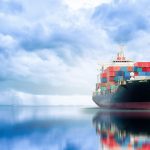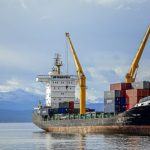This may look like some crates on a cargo ship.
But it’s actually an onboard carbon capture system designed to suck carbon emissions from the air and turn them into stone.
It’s one of the ways the shipping industry is exploring to reduce their climate footprint.
“Could we capture CO2 directly onboard ships to trap their CO2 emissions and reduce them and keep the ship sailing on the water, instead of replacing the whole fleet?”
The global shipping sector transports around 90% of world trade.
It’s also responsible for around 3% of the world’s carbon dioxide emissions.
The U.N. shipping agency has set out targets for the industry to reach net zero around 2050.
But getting there won’t be easy.
Unlike the car industry, for example, shipping cannot simply electrify its fleet to reduce the carbon footprint.
Seabound Co-Founder Alisha Fredriksson explains.
“The options for a ship owner today are very challenging. Essentially, you could order a new ship with a new type of engine that could burn a different type of fuel like ammonia and methanol. But fuel doesn’t exist yet. The new engines are very expensive and they’re not compliant with their existing vessels.”
Another possibility is capturing ships’ emissions and storing them onboard.
UK startup Seabound is developing a carbon capture system designed to fit on the deck of large cargo ships.
A pilot trial on a 45,000 ton container ship, the Sounion Trader, captured around 80% of CO2 emissions and 90% of sulphur dioxide.
“Seabound captures carbon on big ships by exposing the exhaust gas that’s coming out of the engine to little pebbles of calcium oxide, which is also known as quicklime. The pebbles of calcium oxide react with the CO2 in the exhaust gas to make calcium carbonate, which is also known as limestone.”
Carbon capture’s role in emission reductions has so far been limited.
The process is expensive, requires enormous amounts of energy and water to separate CO2 from other gases, as well as heavy upfront capital expenditure in capture plants.
Seabound says their system simplifies the process by decoupling the carbon capture phase from the traditionally expensive recovery and storage phases.
“We just do part of it, which is capturing the CO2 onboard each ship, and then a lot of the post-processing we actually move that to land where we can do it for cheaper, we can do it at larger scale, and we can use land based energy infrastructure.”
The company says they are now working on a larger demonstrator and hopes to capture more than 55 tons of CO2 per day at more than 90% efficiency.
Source: Hellenic Shipping News






